Kanom Jeen is a type of dishes in Thai cuisine that I like to call "Thai spaghetti." This is because in Thailand, we serve these tender rice noodles with various types of sauces, just like you can pair spaghetti with many kinds of sauces! There are even restaurants that specialize in kanom jeen and you can choose from a buffet line of different sauces!
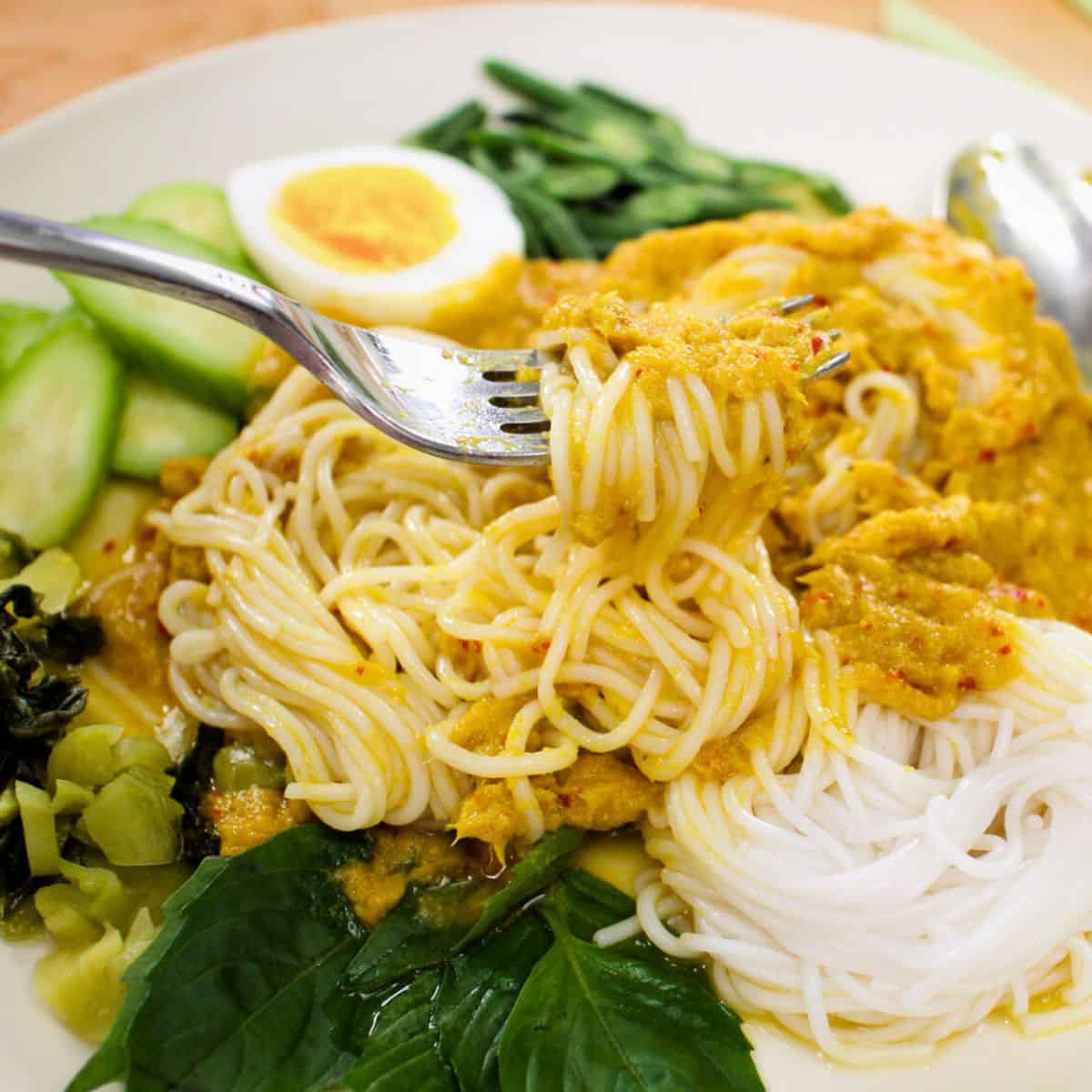
Want to save this recipe?
Kanom jeen namya is arguably the most popular kind of kanom jeen, and it's originated from the south of Thailand, where I grew up. My family used to frequent this street-side restaurant that sells nothing but kanom jeen namya, and it was the most unglamorous of places (no walls, just old wooden tables under a roof), but going there is one of my favourite food memories! They also made it mild enough that even as a little kid, I was able to enjoy it (or maybe I was eating the kid's version...I'm not really sure!).
This is not something you can easily find in Thai restaurants overseas, so definitely something you gotta make if you want to experience it! The key ingredient "grachai" or fingerroot is a bit hard to find, but you can buy it in brine in a glass jar at Asian grocery stores that carry a lot of Thai or Southeast Asian ingredients. If you do find fresh, they freeze very well.
Watch The Full Video Tutorial!
All my recipes come with step-by-step video tutorials with extra tips not mentioned in the blog post, so make sure you watch the video below to ensure success - and if you enjoy the show, please consider subscribing to my YouTube channel. Thank you!
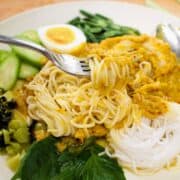
Thai Rice Noodles with Fish Curry (kanom jeen namya)
- Yield: Serves 4
Description
Rice noodles served with an aromatic fish curry sauce. Kanom jeen namya is an iconic dish of southern Thailand, and one of my all time favourites!
Ingredients
- 200 g dry rice vermicelli (see video for the specific type)
For poaching the fish:
- 100 g white fish filet (any kind with a mild flavour)
- 1 stalks lemongrass, bottom half only, smashed and cut into chunks
- 5 rounds galangal
- 1 root grachai or fingerroot, roughly chopped (see note)
Note: If you cannot find fresh grachai, look for ones in brine in a glass jar, available at Asian grocery stores that carry a lot of Southeast Asian products.
For the curry sauce
- 12-15 dried chilies or more to taste, soaked in hot water until softened, seeds optional
- 1 stalk lemongrass, bottom half only, sliced
- 5 rounds galangal
- 3 Tbsp chopped grachai
- 5 cloves garlic
- ⅓ cup chopped shallots
- 1 inch turmeric root, sliced, or 1 tsp turmeric powder
- 1 tsp fermented shrimp paste (gapi)
- 1 ½ cups coconut milk
- 1-2 tablespoon palm sugar, finely chopped, packed
- 2-3 tablespoon fish sauce
- 1-2 tablespoon tamarind juice
For serving:
(The below are all optional, though I highly recommend the pickled mustard greens or another type of sour pickles such as sauerkraut)
- Medium boiled eggs (boil for 7-8 minutes)
- Fresh crunchy vegetables such as bean sprouts, long beans, bitter melon, cucumber, etc.
- Pickled mustard greens (see note)
- Thai basil or lemon basil
Note: You can get pickled mustard greens in clear plastic bags at Asian grocery stores (look for product of Thailand to make sure you have the right one). To use, remove it from the pickling liquid, rinse, then blanch in hot water for 10 seconds; drain and chop.
Want to save this recipe?
Instructions
Poach & pound the fish: Add about 1 inch of water to a medium pot along with the big chunks of lemongrass, 5 pieces of galangal, and the 1 root of grachai. Bring to a simmer then add the fish, letting it poach until fully cooked (you may need to flip the fish halfway through if the water doesn't cover the fish).
Turn off the heat and place the fish into the mortar (or a mixing bowl) and let cool slightly. Fish out the herbs from the poaching water and discard, saving the water.
Once the fish is no longer steaming hot, pound it until fluffy and fine, or without a mortar and pestle you can just mash it in a mixing bowl with a fork or a potato masher. Set aside.
Make the curry sauce: To a blender, add the soaked dried chilies, lemongrass, galangal, grachai, garlic, shallots, turmeric and shrimp paste; then add just enough of the coconut milk to blend. Blend until smooth and pour into the pot that still has the fish poaching water in it.
Add the remaining coconut milk to the pot, the pounded fish, 1 tablespoon of the palm sugar, and 2 tablespoon of the fish sauce. The sauce should look a little too thin right now as it will reduce a bit, so if it looks perfectly thick and luscious, add a little more water to thin it out. Simmer the sauce on LOW heat for 20 minutes, stirring occasionally.
Meanwhile, make the noodles: Bring a pot of water to a boil, add the noodles and cook till tender (mine takes 7 minutes, but this time will differ depending on your specific type of noodles). Drain the noodles and add them to a bowl of cold water. Using your fingers, grab a bunch of noodles with your thumb and middle finger, shaking them under water to release any tangles, then place them in a bundle on a paper-towel-lined plate. Set aside, covered in plastic wrap.
Once the sauce has simmered for 20 minutes, if it looks too thick, add more coconut milk or water. Taste and adjust seasoning with more fish sauce and/or sugar as needed (make it strong since you’ll be pouring this over noodles). Then add the tamarind juice and taste; the tamarind should just bring brightness to the sauce without tasting distinctly sour.
To serve: If you want, steam or microwave the noodles until hot (I find that if the sauce is simmering hot, room-temp noodles are fine), then pour the sauce over the top. Serve with your sides of choice. Enjoy!

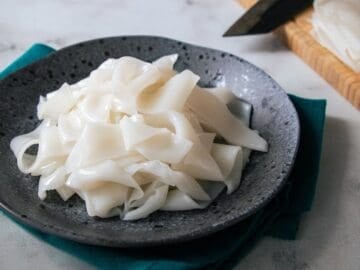
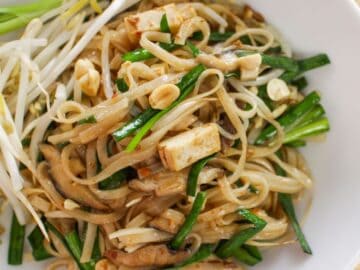
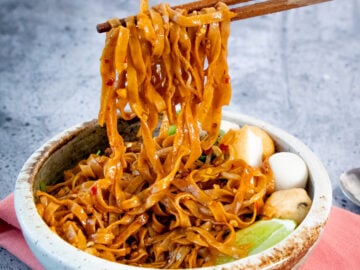
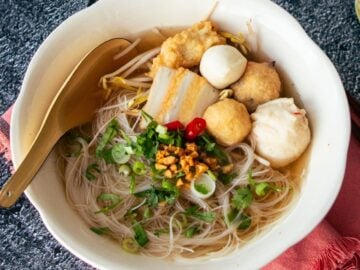
Alyssa says
Just FYI, I found a packet of Namya curry paste at the store in Germany. Would this be a suitable shortcut, any experience with it?
avirambon says
hey
if i dont have grachai .
i can use somthing else or without him?
Pailin Chongchitnant says
You can do it without,or sub more galangal, but grachai is the identifying flavour of this dish so it won't taste quite as it should. Still good though!
Samantha says
Can I substitute dried chillies for fresh ones (or chillie flakes)? If so, what is the ratio?
Thank you so much!
Hendrik says
I like this very much, but find it overly complicated.
Why soak the chilis separately when you have hot water going to poach the fish (FWIW I use fish stock)? Why separate the aromatics and put roughly half in a blender - so hard to clean - when everything goes into the same pot in the end? If there is any deeper meaning to this I'd totally go the extra trouble. But it does seem to me that throwing everything in with the fish and after the fish is done emersion blend away is so much easier and should (?) obtain the same result.
Adam The HTK Minion says
Hi and yep you can totally do it the way you say. Hers is just the traditional method (she tells me). Cheers!
Liv says
Could you make this with red curry paste?
Pailin Chongchitnant says
It won't taste the same, so if you use red curry paste I would add some turmeric and fingerroot to the paste to get the flavour closer.
Bella says
It’s actually not harder or more tedious to do it all separately. I prefer to do it separately maybe because I’m Thai and I enjoy doing it the traditional way. It’s a way to control your ingredients. Maybe sometimes we soak more peppers than we end up using so if it’s separate we can put those extra easily away in the fridge without worry. Whereas if it’s been with the fish you need yo use them sooner. Things like that.
Recipes are important for others to be able to make a dish but I honestly do not know home Thai cooks who EVER actually measure properly. And so doing each step separately allows for gauging spiciness etc.
Might not make sense to you but makes sense to us. And I know people who are not patient with Thai cooking then complain when they hurry and use blenders instead of mortar and pestle or throw everything in together instead of following separate steps and then wonder why the food not taste as good as when made for them.
Melissa Lv says
I put all the herbs in a pot with a can of water and immersion blender away. All the herbs should be cut in 1” or smaller pieces. Add my canned salmon, immersion blend. Coconut milk, blend. Great recipe!
Tina says
The most tedious part of this recipe is gathering all the little mixins for topping to serve. Otherwise it's surprisingly easy to make and very addictive to eat. The flavors are not so in your face bold, but with the toppings every bite is a surprise.
I usually can't find mustard greens so I sub for whatever salty and sour pickle from the asian grocery store. Sometimes pickled long beans!
Stephen Chan says
This is one of my most revisited recipes, because this dish revokes a nostalgic childhood memory of my partner's with his family. Thanks to Pai's great recipes, I could recreate the experience for him.